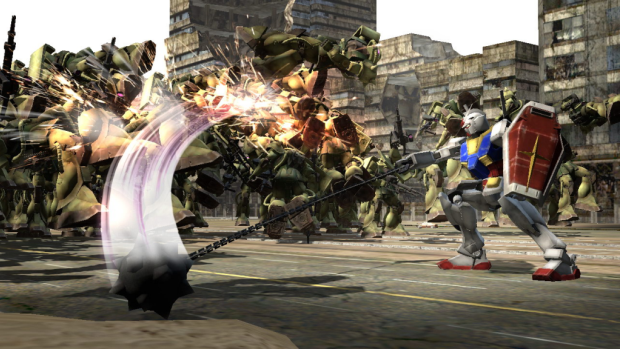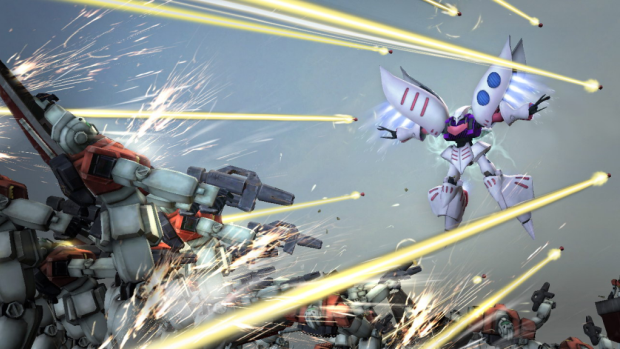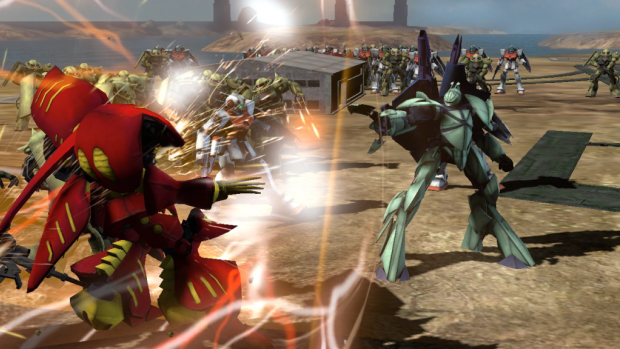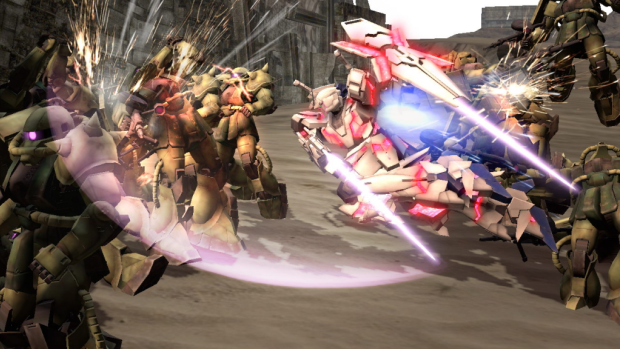Dynasty Warriors: Gundam Reborn Review
Something about Gundam really works within the Dynasty Warriors template. Maybe it’s the guns, maybe it’s the mechs, maybe it’s the big laser death tanks, maybe it’s all of those things combined – but regardless of the exact reason, there’s certainly something about Gundam that works with Dynasty Warriors to the extent that it might just be the best version of the template available.
Ok, well, it depends why you play Tecmo Koei’s infamous man-herding simulator. For those who play the games primarily for Koei’s incredibly murderous spin on the Romance of Three Kingdoms, and because you like to shout “don’t pursue Lu Bu!”, then no, Gundam will not be your favourite simply because it trades Japanese serial killers and classic literature for outer space mass murderers and Gundam. Also, the music isn’t that awful brand of elegance-sacrificing twiddle-y rock, but that’s personal taste.

But to play? Well, that’s where Dynasty Warriors: Gundam Reborn shines. I feel as if the template is on an upward curve – well that, or I’m just experiencing some serious Stockholm Syndrome – but after I proclaimed One Piece Pirate Warriors 2 the best of the musou bunch in my review (“One Piece Pirate Warriors 2, however, is the best twist on the format I’ve played to date” – my words, those), I’m tempted to pin equal, if not greater praise upon Dynasty Warriors: Gundam Reborn.
Why does Gundam work so well? Destruction and speed. As with ordinary Dynasty Warriors games you have two key attack buttons alongside larger, limited attacks and an overdrive state. One of Gundam’s tweaks to the formula is a dedicated ranged button, and an ability to charge said button to unleash bigger projectiles when the moment calls for it. The combat lacks the dodge offset flow of Pirate Warriors but supplements it with the huge attacks that don’t just feel good to pull off, but feel useful within the Dynasty Warriors language in terms of using them to keep enemies under your control.

It helps that Dynasty Warriors: Gundam Reborn is so fast and reactive. You can boost around the maps with remarkable speed, even taking to the air if the moment calls for it, and the game answers this with aggressive power units that you frequently need to head off as they try and take your hard fought portions of the map. Gundam Reborn’s battles feel dramatic and dynamic, helped further by the variety of maps that range from verdant ocean scenes and ruined cities to space cruisers and even outer-space itself.
This sense of gravitas and scale is further enhanced with massive enemies and more dynamic maps. Fighting a basic enemy commander is one thing, but scrapping with a gigantic laser-shooting death mech that stands five times the size of any other Gundam is a unique thrill altogether. The larger fights in Dynasty Warriors: Gundam Reborn adopt an arcade-like splendour as you negotiate huge laser-shows in order to topple mighty Goliaths, all the while cutting a swath through lesser foes in search of health top-ups. It’s surprisingly engrossing stuff – the huge number of potential armours, weapon specialisations and simple-but-worthwhile modifiers build another layer of consideration on top of all that too – and it’s worth highlighting this given the common reputation of Dynasty Warriors encounters being overly simplistic.

Unfortunately, for all of this splendour and success in the game’s brawling, the narrative and presentation disappoint in the usual ways of the franchise. Admittedly it’s just pleasant to have a huge chunk of Gundam narrative here after Dynasty Warriors: Gundam 3 was a touch light on the stuff, and the designers have taken steps to try and tie the talky-talky into the shooty-shooty a touch more with dynamic character choices in fights, going so far as to forcefully swap you from one fighter to another mid combat if the narrative demands it (a small touch, but one that helps the faces feel a bit more like personalities as well as adding authenticity to the game’s re-telling of Gundam from First Gundam up to SEED Destiny) but the presentation is still somewhat lacklustre and aimed more at existing fans of the franchise.
More successful, however, is the game’s Ultimate Mode, which is a series of non-canon mini stories that let you play whoever you want and enjoy missions designed around fun first and narrative later. These segments can be enjoyed with next to no knowledge of the Gundam universe, and their focus on medal criteria and challenges puts a brave and stark emphasis on playing Dynasty Warriors and playing it well.

Oh, and before I close out, the return to a more “realistic” visual style does, in my eyes, feel like a step back after Dynasty Warrior’s 3’s gorgeous cel-shading, but that’s a personal aesthetic preference. The game gets just as visually messy regardless with its hundreds of troops littering the screen – that’s just the norm for the franchise – so it’s all personal opinion that, as with the music, will sit entirely with you.
VERDICT: Dynasty Warriors: Gundam Reborn is a success in an oft-misunderstood genre. What it lacks in the kookiness of its similarly successful One Piece stable-mate it makes up for in bombast, explosions and simple speed and playability. It’s still ultimately Dynasty Warriors, but Gundam Reborn may well be the most accessible, understandable and engrossing interpretation of the Dynasty Warriors template to date.

GOOD. A game that scores 7/10 is worthy of note, but unworthy of fanfare. It does many things well, but only a few of them incredibly well and, despite a handful of good qualities, fresh ideas and solid mechanics, it fails to overwhelm.
Review code provided by publisher.




